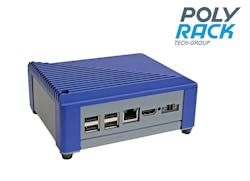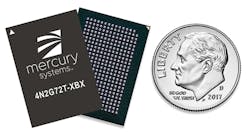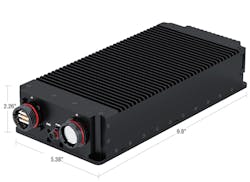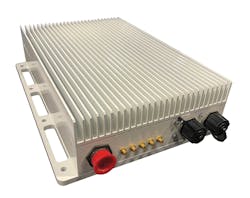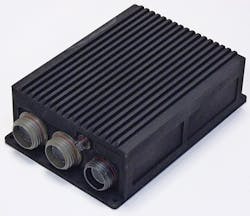Traditional bus-and-board embedded computing architectures are giving way to extremely small boards that can be as small as business cards — sometimes as small as postage stamps — to cram performance into small spaces.
By Jamie Whitney
Size matters.
The best computing systems in the world can’t help modern warfighters take the fight to the enemy if the warfighters can’t take these systems with them. Thankfully, small form factor (SFF) and system-on-chip (SoC) embedded computing solutions are packing more and more power into smaller and smaller rugged enclosures.
For military applications, SFF and SoC solutions often are judged with consideration for size, weight, power, and cost (SWaP-C). SFF systems consist of everything from whole embedded computer systems to down to its miniaturized SDRAM.
Aneesh Kothari, vice president of marketing at Systel Inc. in Sugar Land, Texas, notes that as technology improves, engineers can fit amazing power into very small packages.
“You’re taking data center processing and networking-type capabilities and you’re putting it into SFF SWaP optimized systems,” Kothari says. “As COTS [commercial off-the-shelf] gets more sophisticated, we can take that COTS tech that’s built to common, rugged standards and then that gives you quick time to deployment, and a rich upgrade path if you know you want to accommodate for future technology, it’s relatively simple to add capability down the line.”
Pentek’s Talon Extreme Rugged half-ATR recorder.
“SFF system enclosures come in all shapes and sizes, with a variety of backplanes, interconnect schemes, circuit board definitions, and environmental specifications,” explains Rodger Hosking, vice president of Pentek Inc., in Upper Saddle River, N.J. “SSF systems are not only smaller than traditional COTS solutions, they are also less expensive, lighter, lower power, easier to install, and capable of supporting tough operating environments – all significant and often critical advantages.”
He continued, “SFF systems are still attractive to customers for two major reasons. First of all, the availability of SFF systems with improved SWaP-C metrics opens up entirely new markets and opportunities for critical applications that were previously impractical. Secondly, the industry recognizes the many benefits of breaking up large, monolithic systems into smaller distributed sub-systems, each handling a portion of the system tasks.”
When it comes to small form factor, systems designers are looking for consolidation, points out Chris Ciufo, chief technology officer at General Micro Systems in Rancho Cucamonga, Calif. “We’d stick the VME board in a chassis, yet people wanted more and more and more in a smaller box,” Ciufo says. “Smaller density, small form function was the future. Our claim to fame was to take VME boards and shrunk them into a box that is four inches square.”
In addition to going smaller, what goes inside the ruggedized chassis has changed in recent years as well. “Obviously, we’ve transitioned from spinning drives to solid state disk drives, notes Ciufo. “In the defense industry, no one wants HDD; they want solid state disk drives (SDDs), though solid-state drives have not come down the price density curve as fast as you’d want them to.”
POLYRACK Tech-Group’s SFF EmbedTEC.
On the record
Pentek introduced its Talon RTX 25xx series this fall, which is a SFF recorder product line for extreme operating environments. Optimized for SWaP, the rugged, sealed one-quarter-ATR recorders are available with several input options and has as much as 30.7 terabytes of removable SSD storage. These SFF recorders provide real-time streaming data rates as fast as 4 gigabytes per second for multi-channel, wide-bandwidth RF signal recording.
“Our new extremely rugged half-ATR recorder provides real-time sustained recording rates to 4 gigabytes per second,” says Chris Tojeira, recording systems director at Pentek. He added, “We can capture the full bandwidth of all eight 250 MHz 16-bit phase-coherent A/Ds in this single compact chassis.”
The sealed chassis, which uses military standard circular I/O connectors to control RF emissions, protects the recorder’s electronics from humidity, water, dust, sand, and salt fog. Only the fan is exposed to the outside environment, assuring all system electronics are protected in the sealed chassis. The inner plenum can be replaced to provide other cooling options, such as liquid or conduction cooling.
Designed to operate in temperatures from -40 to 60 degrees Celsius, these recorders can handle most thermal environments, making them suitable for unmanned aerial vehicles (UAVs), aircraft pods, tight equipment bays, military vehicles, and most outdoor environments.
The Mercury Systems compact 16-gigabyte DDR4 SDRAM with a dime for scale.
The Pentek Talon SFF recorders offer an optional GPS receiver for precise time and position stamping. Additional QuickPac drive packs with 3.8 to 30.7 terabytes are available. Computer I/O on all models includes Gigabit Ethernet, USB 3.0, RS-232, and HDMI.
“Most SFF systems incorporate a processor to manage internal resources and to communicate with the outside world for status and control,” Hosking says. “Unless a custom control processor is required, designers have many popular standards to choose from, including Mini-ITX, COM Express, PC/104-Express, and derivatives. Using Intel, ARM, or AMD CPUs, these boards are actually small PCs with various configurations of SDRAM and FLASH memory along with USB and serial ports, PCI Express, and SATA interfaces.”
Micro machines
The General Micro Systems Peacock III S1202-XVE rugged, low-profile video server has an Intel Xeon E3 workstation CPU and triple 4K video, with a general-purpose graphics processing unit (GPGPU) coprocessor into a sealed enclosure measuring 9.8 by 5.38 by 2.26 inches
GMS can fit as much as 63 gigabytes of DDR4 RAM into its case, along with a 1 terabyte SSD, and a removable 2.5-inch SSD that holds as much as 4 terabytes. The S1202-XVE standard configuration supports four 1 Gigabit Ethernet and two 10 Gigabit Ethernet channels with TCP/IP offloading engine (TOE), four USB 2.0 ports with power, four USB 3.0 ports, eight buffered digital I/O lines, one DVI/HDMI and one R gigabyte of video port, and a full HD-audio headset jack and a 5-Watt audio amplifier and mic-in. Additional I/O functions include one expansion I/O site (SAM) for I/O such as GPS, Video capture, CANbus, MIL-STD-1553, ARINC-429, and more on a PCI Express-mini card.
The General Micro Systems Peacock III S1202-XVE is a rugged, low profile video server.
The conduction-cooled SFF server is equipped with a SecureDNA security suite including write protect and secure erase to all non-volatile storage, BIOS erasure, all firmware erasure.
GMS also offers a paired micro-server solution in its Golden-Eyes II S2002-MD. The two independent systems come with an Intel Xeon processor D with as much as 64 gigabytes of DDR4 RAM, and two 10-gigabit and three 1-gigabit Ethernet ports. The S2002 is an ultra-rugged, small, lightweight multi-domain server system with as many as 16 CPU cores and removable drives. It is designed to provide two fully-independent and isolated high-performance servers in one box while providing high workstation performance in a ruggedized, conduction-cooled, sealed system, operating from -40 to 75 C. Even the power supplies are separately isolated.
Golden-Eyes II is for military, aerospace, industrial, and commercial Red/Black networks — such as found on platforms with SIPR/NIPR networks. With the onboard 1- and 10-Gigabit Ethernet ports, Golden-Eyes II is suited as a forwardly deployed vehicle-mounted battlefield dual-server that offers double performance or redundancy. Alternatively, the S2002-MD works as an airborne network multi-domain server that also can drive operator consoles, such as in an ELINT platform, while recording data and distributing it to several Ethernet LANs.
“With two of these small form factor boxes, with the platform collecting signals intelligence, they can go through the data twice. The second system comes up with additional intelligence,” says GMS’s Ciufo.
Thanks for the memory
BuiltSECURE technology from Mercury Systems in Andover, Mass., miniaturizes DDR4 SDRAM memory in a compact ruggedized package. These devices are suited for military and commercial aerospace applications requiring SWaP-optimized high-speed SFF DDR4.
While Mercury describes its SDRAM as “compact,” it is safe to call it downright tiny. The 2-gigabyte model comes in at 8-by-14-millimeter package, and the SDRAM models come in 2, 4, 8, and 16 gigabytes. Mercury officials say their unique DDR4 SDRAM has an 83 percent space-savings compared to discrete chip, and has as much as 93 percent component reduction.
The SDRAM has a data transfer speeds as fast as 2666 megabits per second and can operate in temperatures from -55 to 125 C, which makes it suitable for military applications.
Pixus Technologies RX310 commercial software defined radio.
Mercury also offers a SFF solid state drive in its TRRUST-Stor BGA line. The modules allow integration of high-capacity secure storage onto printed circuit boards. Attaching the storage to the circuit board eliminates the cost and reliability issues associated with high-speed cabling.
It also removes the potential for tampering by hot-swapping the data cable or probing plaintext data running from the host to the SSD.
The Mercury TRRUST-Stor BGA SSD product line incorporates Mercury’s Sixth Generation Armor NAND Processor and 3D TLC NAND running in SLC mode. The TRRUST-Stor BGA is available with a 6 gigabit-per-second SATA interface or a fast 4-lane, NVMe interface.
Weighing in at eight grams, the TTRUST-Stor BGA SSD line measure 32 by 22 by 3.5 millimeters and has a host-accessible capacity of 80 to 160 gigabytes. Like the SDRAM, the SSD was designed and built in a DMEA-accredited facility, has self-destruct capability, and can operate in temperatures from -40 to 85 C.
Tuning in
This winter, Pixus Technologies in Waterloo, Ontario, rolled out the first in a planned series of SFF ruggedized commercial software defined radios (SDR) from Ettus Research in Santa Clara, Calif. SDRs use software for what was previously accomplished by hardware.
The SDR sits in a weatherproof enclosure and features IP67 sealing for water and dust ingress. It also is designed to MIL-STD-810 for shock and vibration, as well as to MIL-STD-461 for electro-magnetic interference.
The RX310 contains two extended bandwidth daughter board slots covering 10 MHz to 6 GHz with as much as 160 MHz of baseband bandwidth, dual 1/10 Gigabit Ethernet high-speed interfaces, and a large user-programmable Kintex-7 field-programmable gate array (FPGA).
ECRIN Systems Nano-Onyx ultra-SFF mission computer.
The unit is 302 millimeters wide, 400 millimeters long, and 98 millimeters tall with conduction-cooled fins for heat dissipation.
The RX310 series can be used in various types of airborne, shipboard, ground vehicle, or outdoor designs. Applications include signals intelligence, spectrum monitoring, passive radar, smart agriculture, smart energy, and prototyping systems for advanced wireless standards. Pole-mount and other special mounting options are available.
Light-rugged versions of the enclosure also are available, as well as ruggedized versions of other software defined radios offered by Ettus Research.
Embedded SFF solution
German-based POLYRACK TECH GROUP in Straubenhardt, Germany, showed off its SFF enclosures at Nuremberg’s embedded world conference in late February, including its EmbedTEC.
The aluminum tabletop case is designed for small form factors such as embedded NUC (eNUC), pico-ITX (pITX, 2.5-inch), SMARC, QSeven, and single-board computers, as well as the Raspberry Pi.
It comes with a changeable front I/O Shield as well as a large aluminum cover for the heat dissipation. Alternatively, perforated side panels or small fans can add to the cooling performance on top. POLYRACK also offers various adaptations and mounting option.
All on one
Extreme Engineering Solutions (X-ES) in Verona, Wis., continues to provide solutions in the SFF sector with its XPedite7683 single-board computer. The Xpedite7683 is a secure 3U OpenVPX based on the Intel Xeon D-1500 family of processors.
The computer board provides as many as 16 Xeon-class cores, as much as 32 gigabytes of DDR4-2133 ECC SDRAM, and XMC support, and is for computationally heavy applications requiring maximum data and information protection.
The XPedite7683 integrates Secure COTS technology with a Microsemi SmartFusion 2 security SoC for hosting custom functions to protect data from being modified or observed and provides a solution when stringent security capabilities are required.
The Microsemi SmartFusion2 can control, intercept, and monitor the Xeon D subsystem, implement penalties, and interface to the system through GPIO directly connected to the VPX backplane. Circuit board enhancements and optimized two-level maintenance (2LM) metalwork provide additional protection to the physical hardware.
Wind River VxWorks and X-ES Enterprise Linux Support Packages (XEL) are available. The XPedite7683 uses coreboot, powered by Intel’s Firmware Support Package (FSP), to provide fast boot times and can simplify code traceability over legacy BIOS implementations.
Bird of prey
Last fall Systel unveiled the SFF Falcon-Strike combat vehicle computing. The Texas-based company fits the system in an 8-by-9.5-inch enclosure that stands 6-inches tall. The Falcon-Strike uses either an Intel Xeon E3-1505L Quad-Core or i7-6822EQ Quad-Core CPU with a NVIDIA GeForce GTX 1050Ti 768 CUDA Cores GPU.
“Falcon-Strike exceeds the technology challenges and performance specifications demanded by modern defense programs and platforms,” says Systel’s Kothari. “It provides an unmatched processing combination of high-performance CPU and GPU, ultra-efficient multi-sensor capture and encode, I/O and board scalability, and secure storage – all in a SWaP optimized, single Line Replaceable Unit.”
Falcon-Strike features four HD video inputs as much as 1080-pixel resolution, as well as four HD video outputs, and a pair of 1-terabyte SSDs.
Falcon-Strike is an extreme duty system designed for mission-critical military operations involving intelligence, surveillance, and reconnaissance (ISR), counter-UAS (C-UAS), persistent surveillance, airborne law Enforcement (ALE), search and rescue (SAR), and land- and marine-based missions.
What’s next
ECRIN Systems in Crolles, France, is developing what it calls an ultra-SFF rugged mission computer for aerospace and UAV applications, which it is calling Nano-ONYX in its COTS mission computer line.
The Nano-ONYX is slated to have a COM-Express Module with an Intel Atom E3900 Series processor up to an Intel Core i7-7600U, as well as I/O expansion slots.
ECRIN also plans to include 4 gigabytes of DDR3L SDRAM. All that technology will sit inside a ruggedized chassis that measures 20 centimeters long, 13.5 centimeters wide, and 6.5 centimeters tall.
company list
Aitech
Chatsworth, Calif.
http://www.rugged.com
Crystal Group
Hiawatha, Iowa
https://www.crystalrugged.com
Curtiss-Wright Defense Solutions
Ashburn, Va.
http://www.curtisswrightds.com
Extreme Engineering Solutions, Inc.
Middleton, Wis.
https://www.xes-inc.com
General Micro Systems
Rancho Cucamonga, Calif.
https://www.gms4sbc.com
Kontron
Fremont, Calif.
https://www.kontron.com
Mercury Systems
Andover, Mass.
http://www.mc.com
Panasonic USA
Newark, N.J.
http://www.toughbook.com
POLYRACK TECH-GROUP
Straubenhardt, Germany
https://www.polyrack.com/
Systel
Sugar Land, Texas
http://www.systelusa.com
AcroMag
Wixom, Mich.
https://www.acromag.com
ADLINK Technology
San Jose, Calif.
http://www.adlinktech.com
Chassis-Plans
San Jose, Calif.
http://www.chassis-plans.com/
Core Systems
Poway, Calif.
https://core-systems.com
Diamond Systems
Sunnyvale, Calif.
http://www.diamondsystems.com/
Ecrin
Crolles, France
http://www.ecrin.com/en
Elma Electronic
Fremont, Calif.
http://www.elma.com
GammaTech Computer Corp.
Fremont, Calif.
https://www.gammatechusa.com
Getac
Irvine, Calif.
http://www.getac.com
HHCS Handheld USA Inc.
Corvallis, Ore.
https://www.handheldgroup.com
MilDef Inc.
Alexandria, Va.
https://www.mildef.com
North Atlantic Industries
Bohemia, N.Y.
https://www.naii.com
Pentek, Inc.
Upper Saddle River, N.J.
https://www.pentek.com
Sparton Rugged Electronics
Woodbridge, Ontario
https://www.spartonre.com
Technology Advancement Group (TAG) Inc.
Dulles, Va.
https://www.tag.com
V Rose Microsystems
Johnstown, N.Y.
http://www.vrosemicrosystems.com
Xplore
Austin, Texas
https://www.xploretech.com

